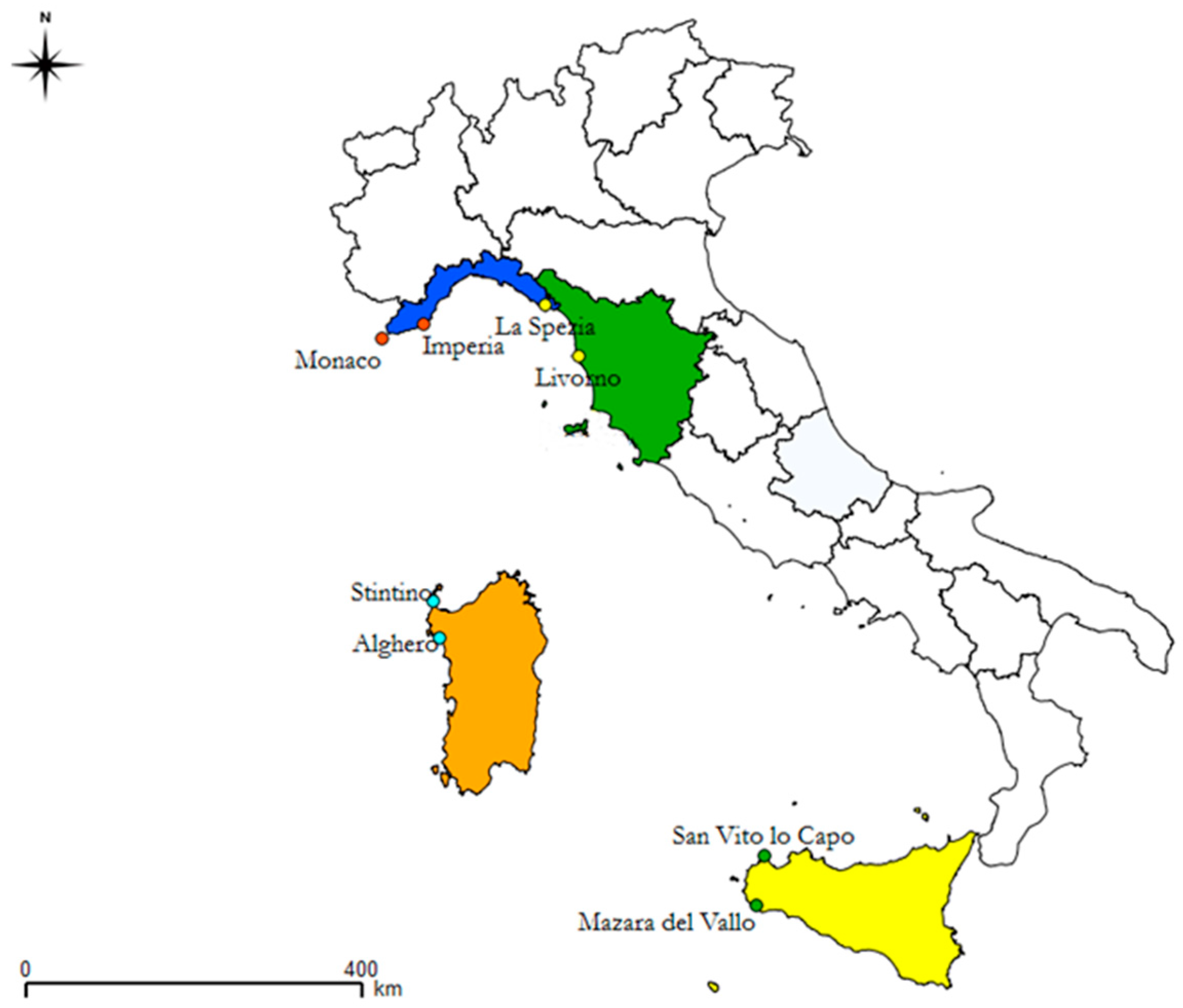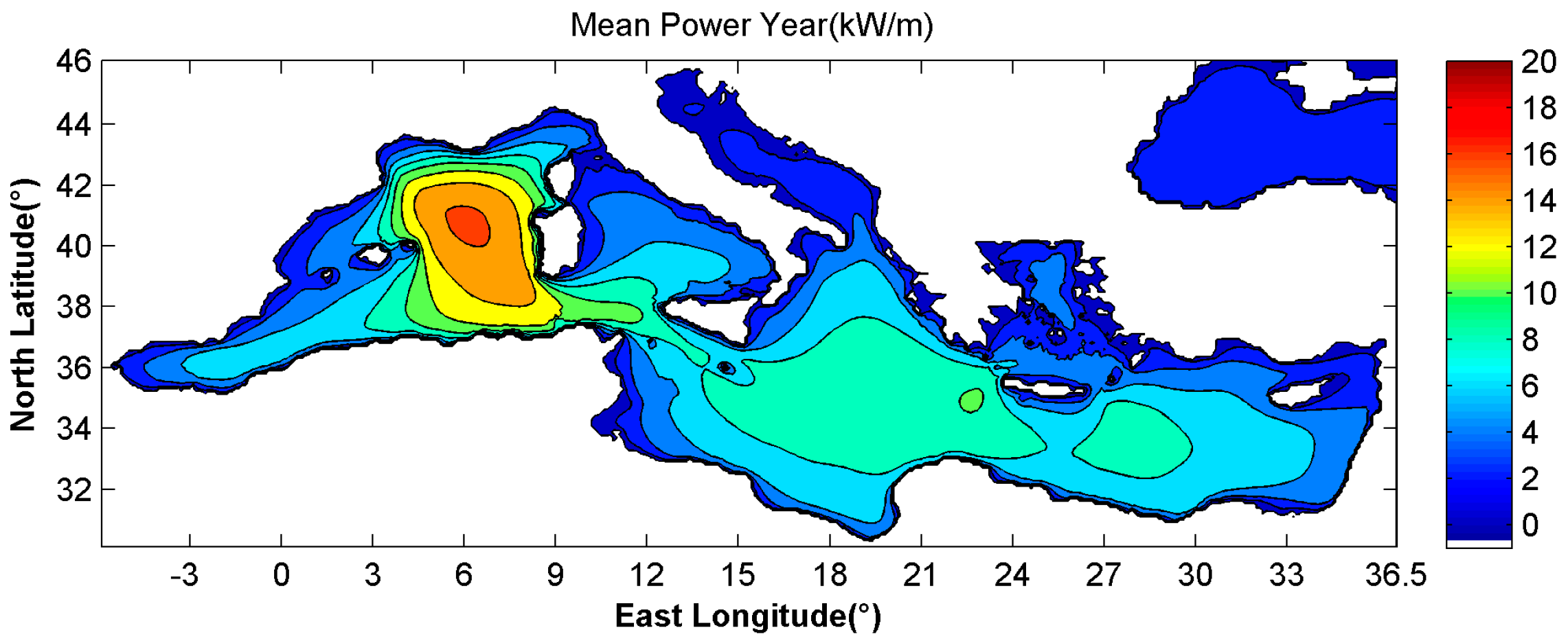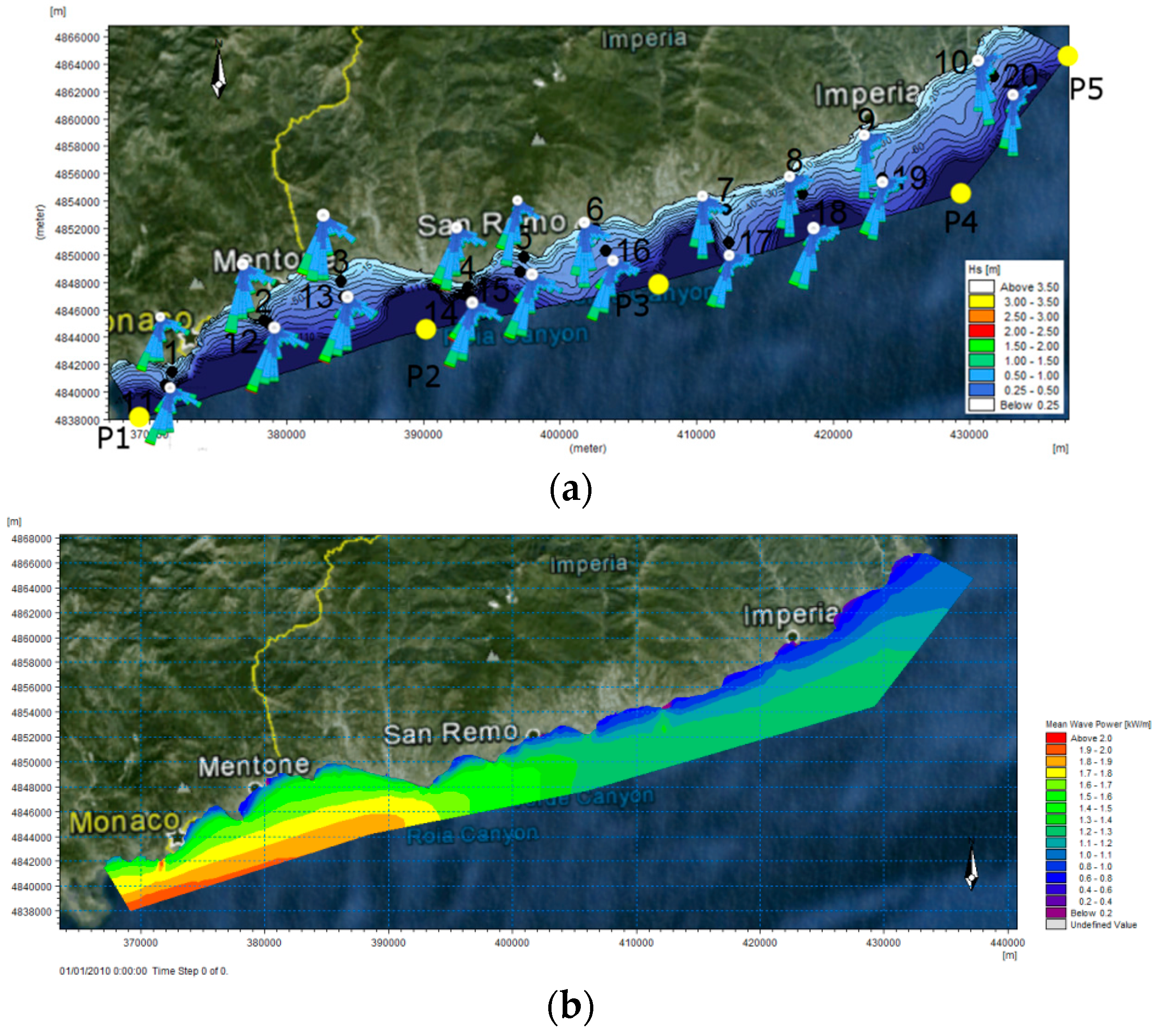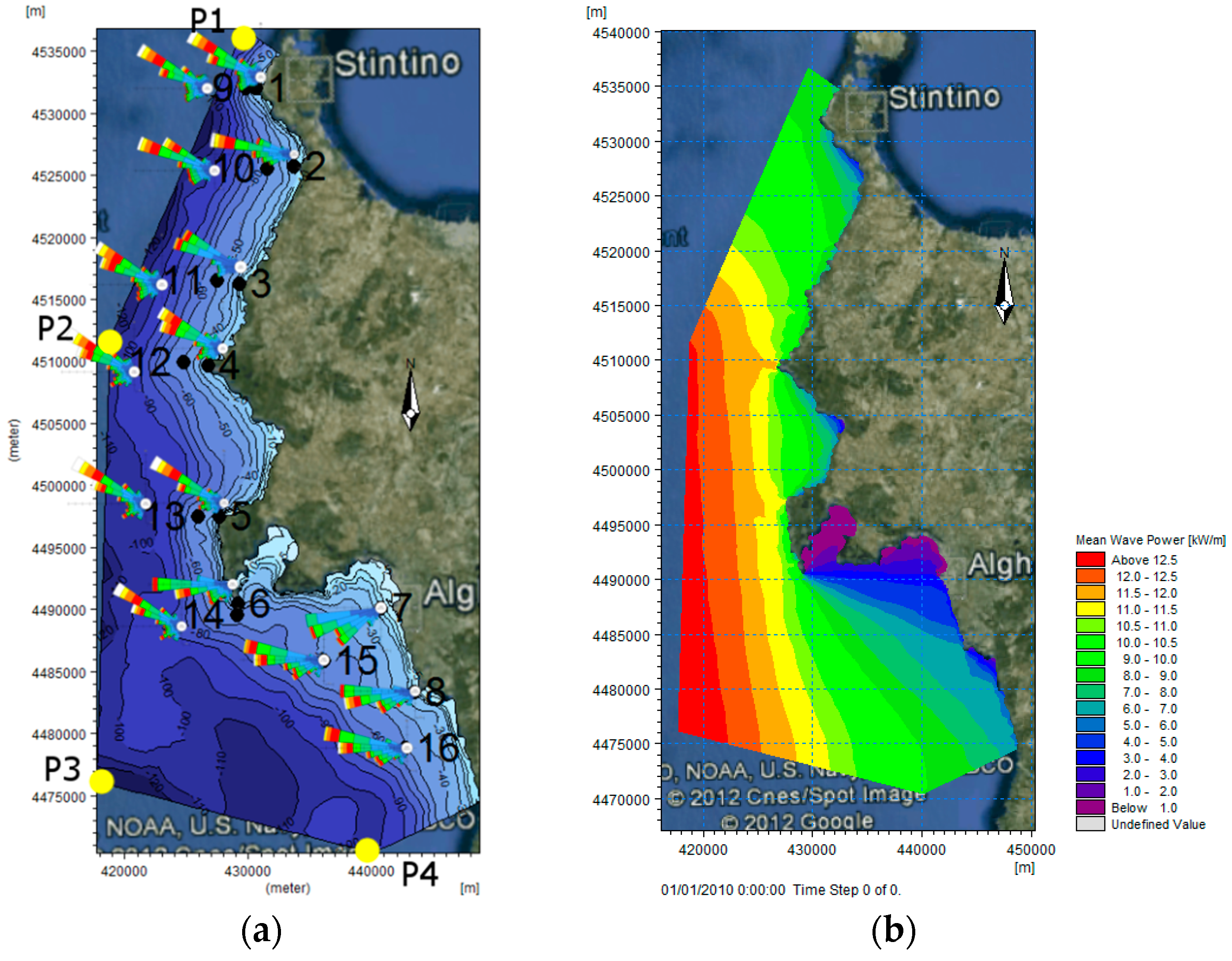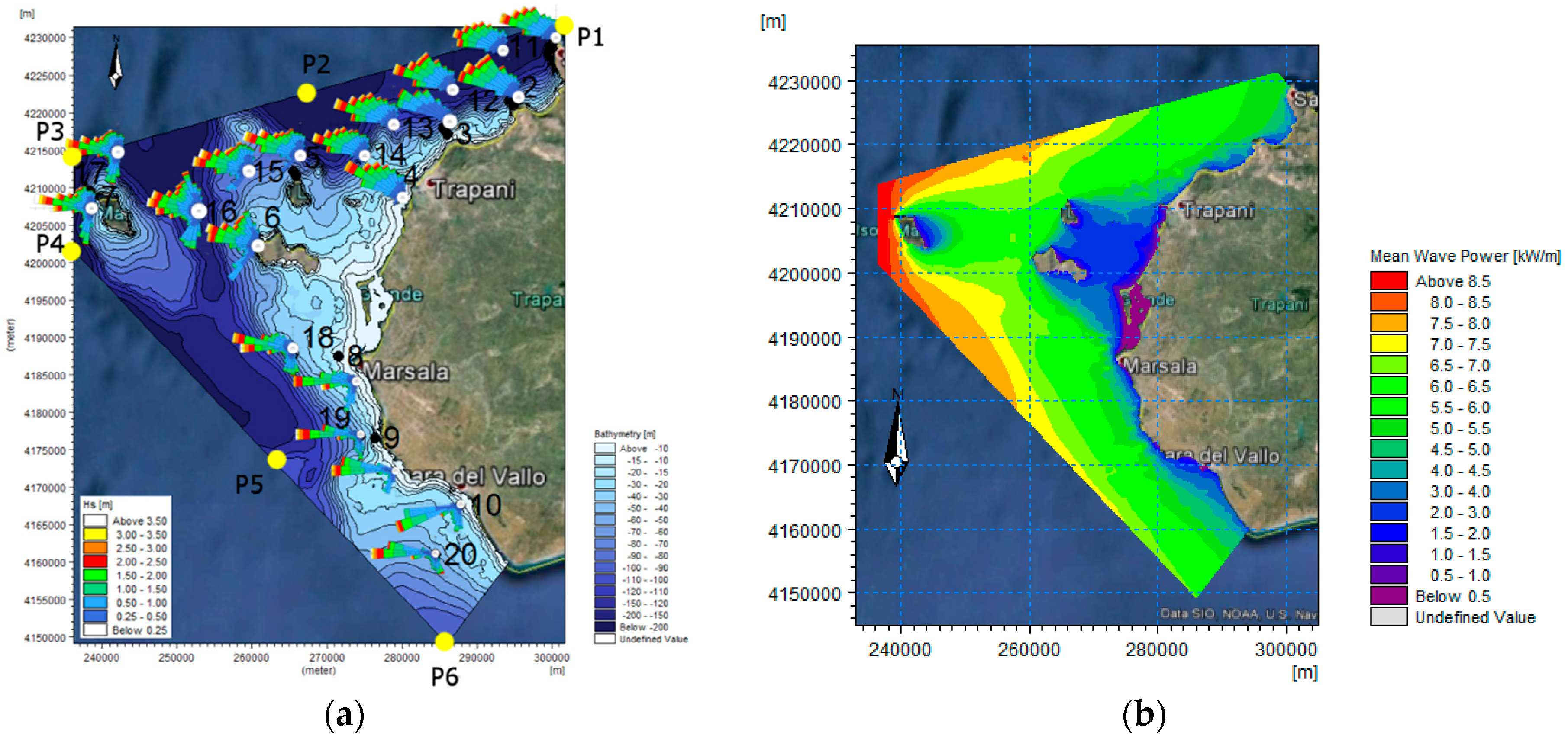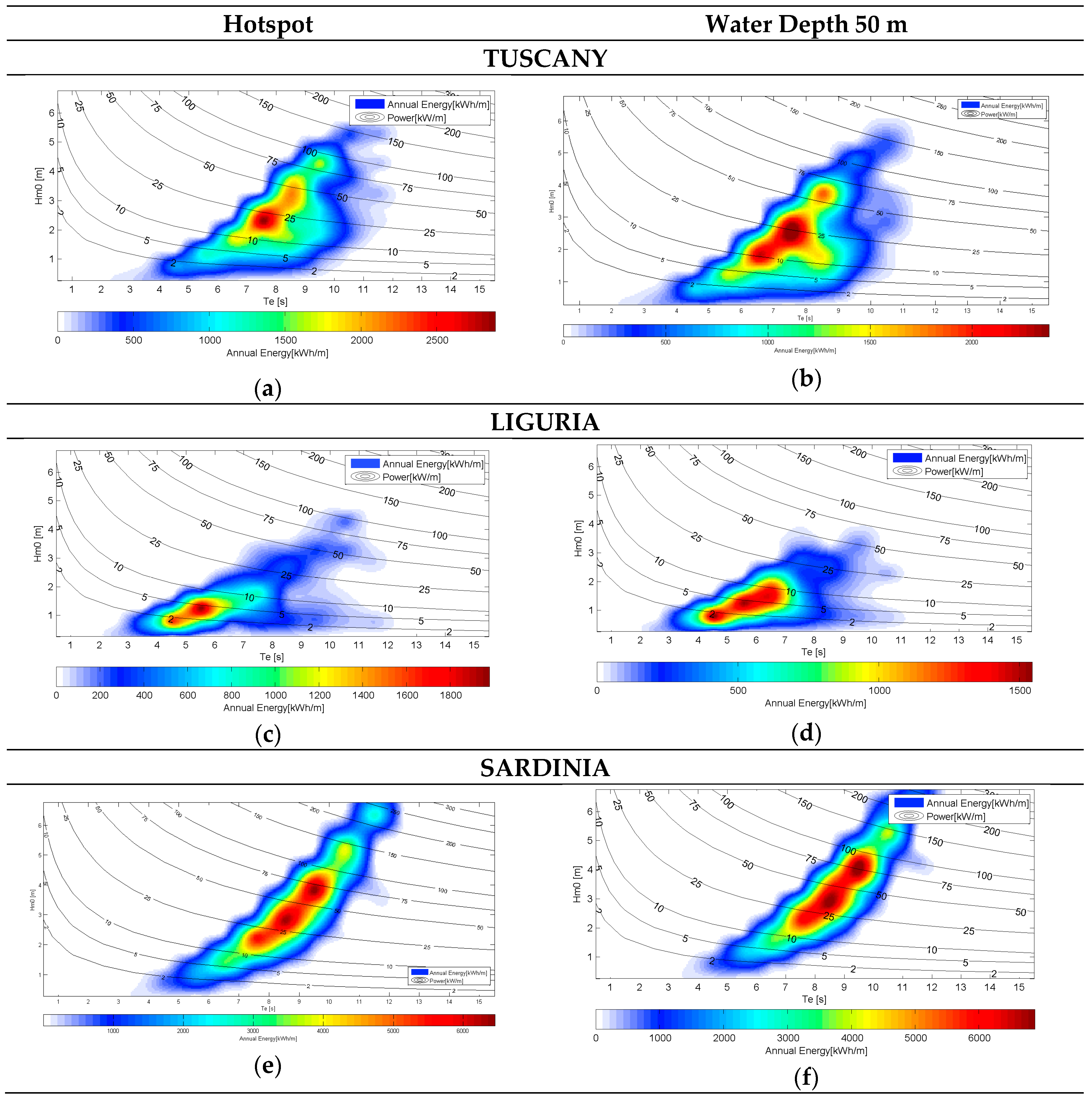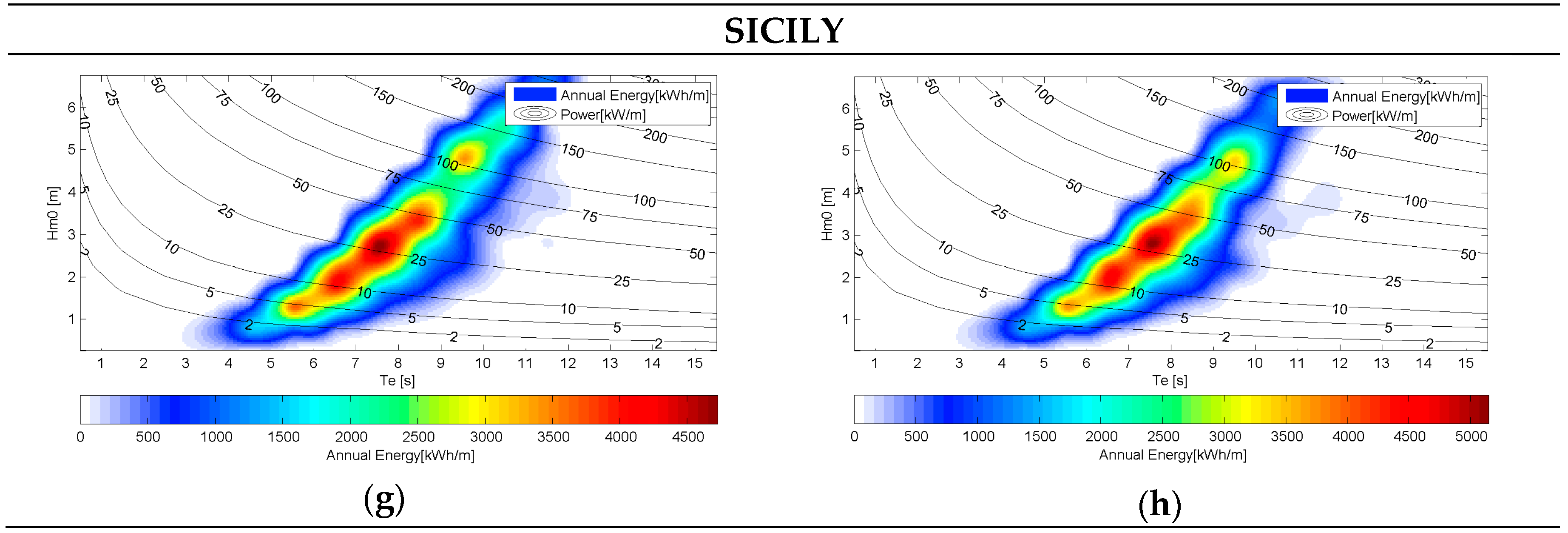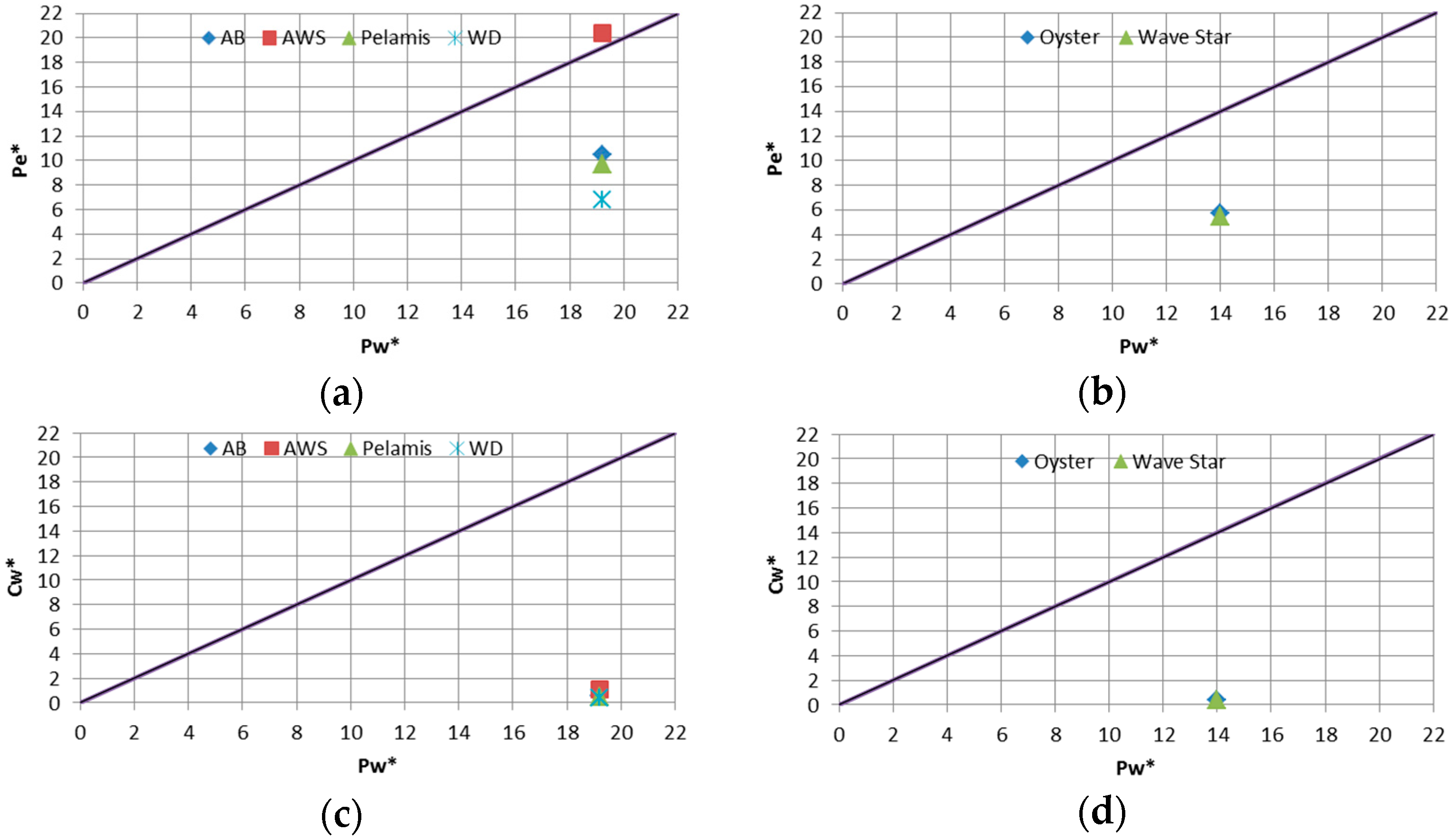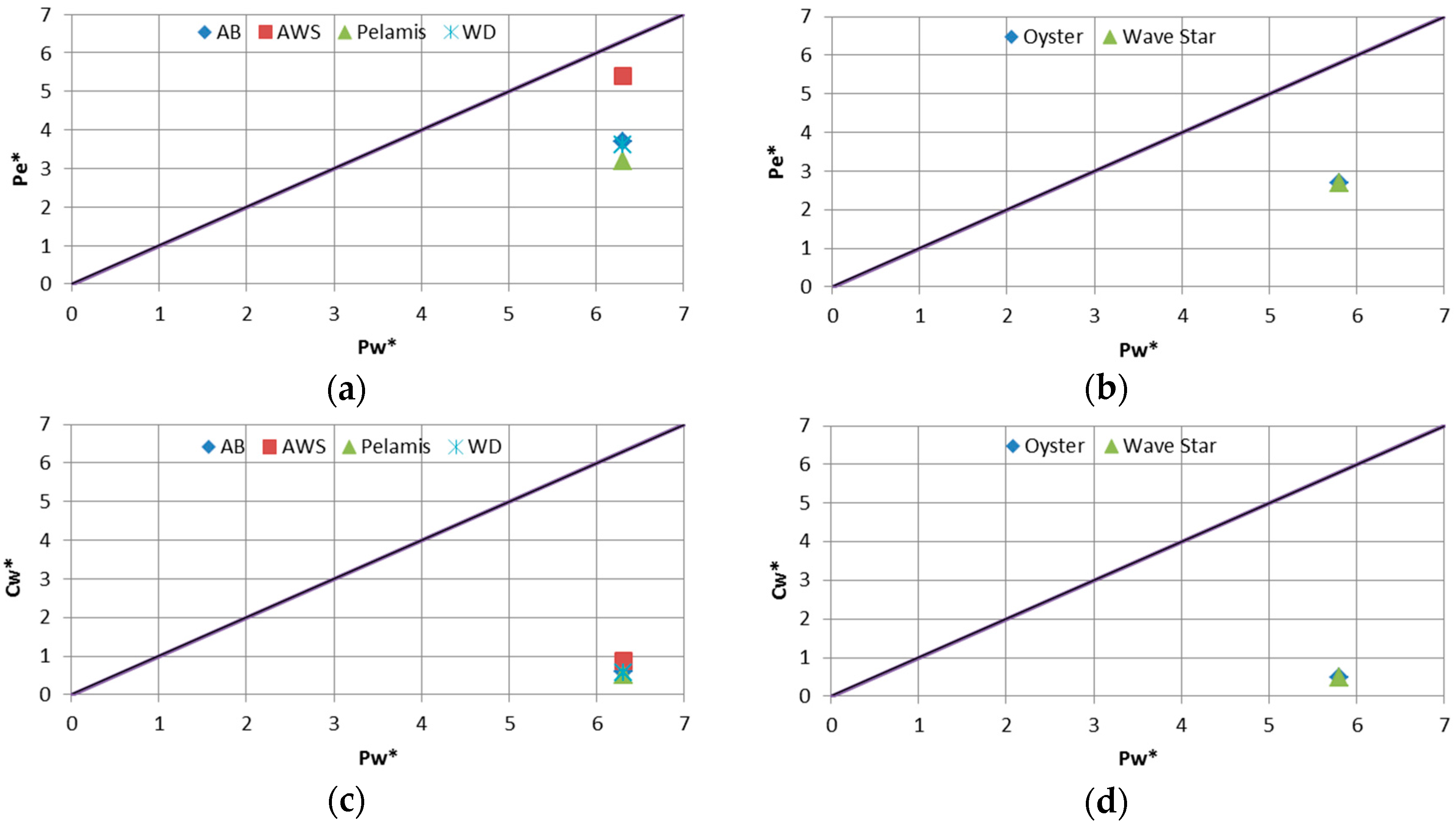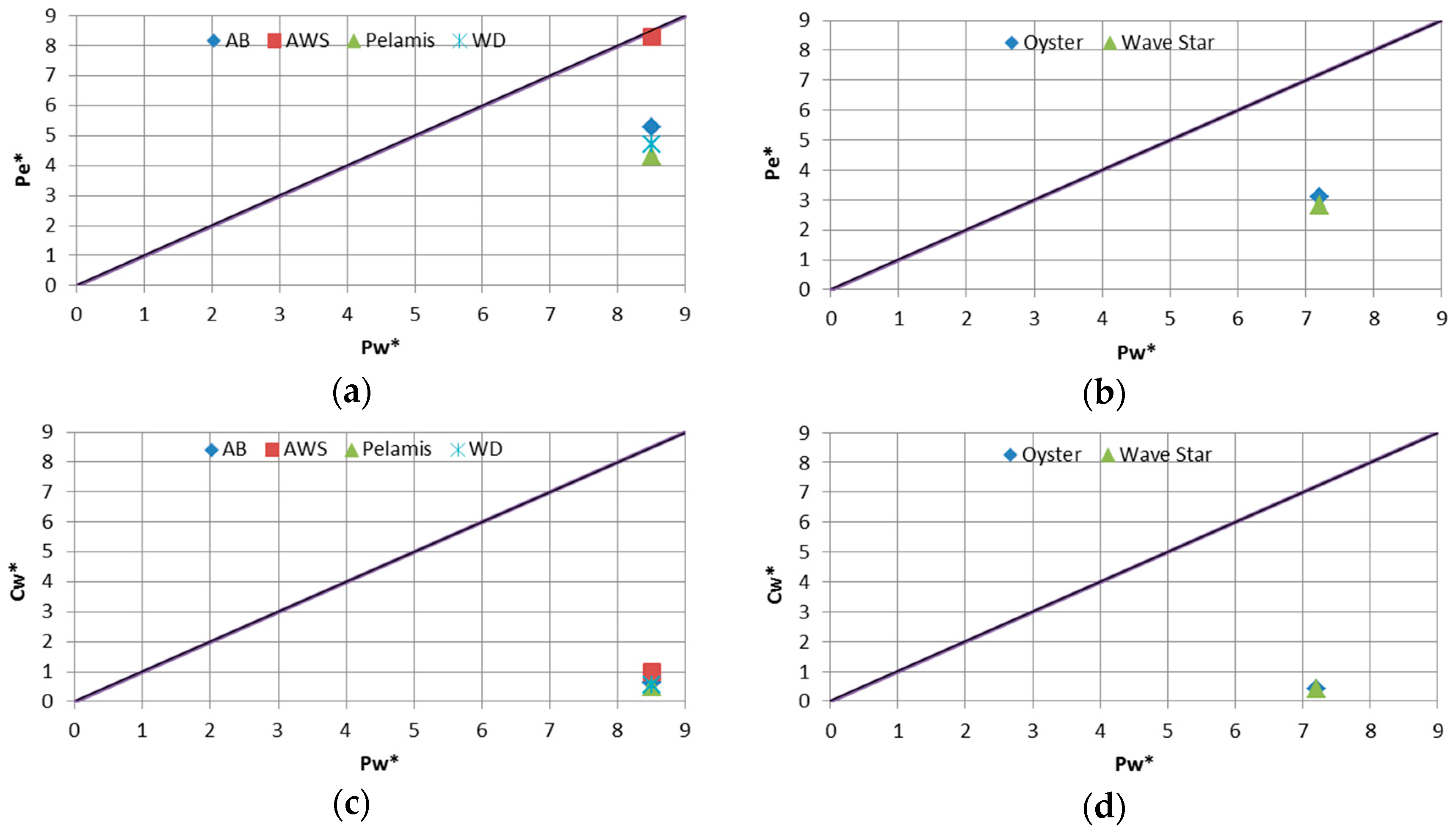1. Introduction
Due to the depletion of fossil fuel energy resources and the environmental impacts related to their use, the interest in the exploitation of renewable energy sources has been growing for many years and, in this context, the energy of the sea waves is emerging. The wave energy is the renewable energy source having the highest energy density and a global wave energy potential of 32,000 TWh/year is estimated to reach the world coastlines, a value close to the yearly mean world energy consumption [
1]. Various Wave Energy Converters (WEC) have been proposed so far but these technologies have not yet reached the commercial level [
2]. Among all the technical issues that impinge the development of WECs, resistance to extreme wave loads is one of the most challenging. If, on the one hand, the sea sites where the wave energy is relatively high offer higher energy potentials, on the other hand, the presence of high waves leads to heavy loads on the WECs, thus increasing the failure probability and so decreases the overall productivity. Seas with moderate wave climate, with respect to the oceanic conditions, such as the Mediterranean Sea or the North Sea might offer a good compromise for the exploitation of such kind of energy and act as test areas for prototypes in view of their development for the more energetic oceanic sites.
Studies on the assessment of wave energy potential in candidate sea sites for building pilot plants and the performance estimation of WECs in those sites are still needed in order to support the cost–benefit analysis of these technologies.
The siting of pilot plants for the exploitation of wave energy by means of WECs is a technical, economic and strategic problem. The assessment of wave conditions is necessary to estimate the wave energy resource available in the area of interest and to optimize the design of WECs for the specific wave climate. Due to non-technical factors [
3] such as cost of investments for building, control, maintenance and energy transportation by submarine cables, nearshore areas are the candidate areas due to their proximity to the coast and harbors. However, once waves propagate toward the shore, part of their energy is dissipated due to frictional losses. At the same time, their interaction with the sea bottom and coast features like shoals, headlands and bays, induce refraction mechanisms that may lead the offshore wave energy to spread on a wider area or to focus on a smaller area. Considering the characteristics of the waves of the Mediterranean Sea, once the water depth is greater than about 15 m, the energy dissipation due to bottom friction or breaking is almost zero and the mentioned focusing mechanisms may lead to coastal areas where the wave energy potentials are higher than the related offshore values. Thus, the assessment of wave energy at coastal areas is pivotal in order to locate the hotspots for the exploitation of the wave energy resource.
The purpose of this work is the assessment of the energy potentials on the offshore of the whole Mediterranean Sea, the selection of the most promising Italian nearshore areas and the location of their hotspots, the evaluation of performances of state of the art WECs and comparisons between their energy productivity in Mediterranean hotspots and in EU oceanic hotspots.
The aims are to contribute to the present knowledge on energy assessment and selection of Italian sea sites for the exploitation of wave energy and to select some of the proposed WEC technologies that are most suited for the Mediterranean Sea climate. The content of this paper is of evident interest for the EU and Italian communities that are investing in this field as well as companies worldwide that are developing WEC technologies and thus need to optimize the device for specific wave climate in order to reach the level of commercial maturity.
The results of this study discover the exact place of some hotspots where thanks to focusing phenomena the wave energy potentials are higher than those in their surrounding areas. This finding would have not been achieved if numerical models with appropriate spatial resolution were not used; it suggests, to the research community, the need of such methodological approach. Moreover, this work proves that, although the energy potentials of the ocean sites are higher than those in the Mediterranean sites, this difference is drastically reduced in terms of the energy productivity potentials of existing WECs even though none of the tested technologies were optimized for the moderate wave climate. It suggests that, if the WEC technologies were optimized for moderate wave climate their production of energy would approach the values that characterize the oceanic sites. This latter result might contribute at the opening of a new market for WECs devices since, at present, they are under development just for the most energetic oceanic climates.
The paper contents are structured as follows.
Section 2 provides a review of current state of research on each of the three topics, namely offshore assessment, nearshore assessment and performance estimation of WECs.
Section 3 describes the wave data used for the offshore assessment, the methodology used for the nearshore wave propagation and a brief review of the state of the art WECs considered in this study. The assessment of the offshore and nearshore wave energy potential is presented in
Section 4. Performance analyses of seven state of art WECs are discussed in
Section 5. Conclusions are drawn in
Section 6.
4. Wave Energy Assessments
The spatial distribution of the offshore wave power for the whole Mediterranean Sea is shown in
Figure 3 (mean values related to the used hindcasting period). The higher values (above 10 kW/m) are located in the Central Mediterranean and the maximum value, which reaches 16.4 kW/m, is located between Corsica Island, Sardinia Island and the Balearic Islands. In the Eastern Mediterranean Sea, the wave power values are between 6 and 9 kW/m. The lower values are located in the Adriatic Sea (below 2 kW/m).
Similar analyses, still based on numerical wave hindcasting as done in the present study, have been conducted by Liberti et al. [
17] and Besio et al. [
19]. It is worth noting that, although the length of the hindcasted periods used are very different, the results in terms of the spatial distribution and local magnitudes of the yearly mean wave power are almost identical among all the three studies.
The spatial distribution of the nearshore wave power at the four studied areas are depicted in
Figure 4b,
Figure 5b,
Figure 6b and
Figure 7b, while
Figure 4a,
Figure 5a,
Figure 6a and
Figure 7a show the location of the points (Pi) used as offshore boundary conditions and the location of points, on water depths of 50 m and 15 m, where the wave powers are plotted as wave roses and the maximum values are summarized in
Table 2. Following Cornett [
6], the coefficients that aim to describe the temporal fluctuation of the wave power were also computed (COV Equation (3), SV Equation (4) and MV Equation (5)).
In the case of the Tuscany (
Figure 4), the wave power decreases during the propagation toward the coastal waters except at a location in front of Livorno where it reaches values higher than those along the offshore boundary (
Figure 4b). This is clearly related to wave focusing due to refraction processes that are triggered by the presence of the Meloria shoals (
Figure 4a). This hotspot is located in 10 m of water depth (
Table 2) about 1400 m shoreward of point 9. The mean wave power reaches 4.7 kW/m, a value about 25% larger than the value at the closer offshore boundary points P4 (3.6 kW/m) and P5 (3.9 kW/m). It is worth noting that at a distance of 1.5 km around this hotspot the wave power potentials dramatically decrease. This result motivates the necessity of high spatial resolution for the assessment of wave energy potentials in order to locate the most promising site for wave energy pilot plants. The COV values everywhere are lower than 1.7, the SV values everywhere are below 1 and the MV values are lower than 1.8 on water depths below 20 m.
In the case of the Liguria area (
Figure 5b), the highest values of wave power, on 15 m water depth, are located at point 1 where it reaches 1.9 kW/m, while in the case of 50 m of water depth the highest values are located at point 11 where it reaches 1.8 kW/m. Both points are located in front of Monaco (
Figure 5a). The wave roses of these two points show that the main wave direction was S-SW. The French side of this nearshore area is characterized by high bathymetric gradients so that the transition from deep to shallow water is very sharp and as a consequence the waves propagate close to the coast without losing energy. The hotspot of this area is located only 210 m shoreward of point 1, on 10 m water depth, where the wave power reaches 2 kW/m (
Table 2). The COV values are approximately equal to 1.8 in the whole area, the SV values everywhere are below 0.6 and the MV values are in the range 1.7–2.
On the nearshore area along the Sardinia coast (depicted in
Figure 6b), according to the results of the offshore assessment, the wave power values are much higher than those at the other nearshore areas. The northern part of this nearshore area is characterized by high bathymetric gradients and the focusing mechanisms induced by refraction effects occur near the headlands on the Argenteria area on the north of Capo Caccia. The maximum value of the mean wave power (
Table 2) on 20 m of water depth reaches 11.4 kW/m (point 4) while in the case of 50 m water depth it reaches 11.7 kW/m (point 12). The wave roses of these two points show that the main wave direction was NW. Point 4 is also the hotspot of this area. The wave power potentials at this hotspot are more than two times larger than the potentials at the Tuscany hotspot and almost six times larger than the value at the hotspot on the Liguria coastal area. The COV values are above 1.8 across the whole area. The SV values are above 1.3 in the whole area: these values were 50% larger than those obtained in the Tuscany area. The MV values were lower than 1.8 and lower than those obtained in the Tuscany and Liguria areas.
Vicinanza et al. [
33] studied the nearshore area along the NW of Sardinia. The nearshore simulation was performed with the MIKE 21 NSW model that was forced with wave data measured at the Alghero wave buoy (period 1989–2009). They reported the wave power at seven coastal points and found a largest value of 10.91 kW/m in front of Torre su Pittu bay (out of our domain).
In the case of the nearshore area at Sicily Region, the area between San Vito lo Capo and Mazara del Vallo was analyzed (
Figure 7). The lowest energetic area is between Trapani and Marsala due to the protection of the Favignana and Levanzo Islands. The most energetic area is in front of the Marettimo Island. The maximum value at 15 m water depth reaches 9.1 kW/m (point 7) while at 50 m water depth it reaches 8.6 kW/m at point 17 (
Table 2). Focusing mechanisms are identified on the NW coast of Marettimo Island and at Punta Mugnone area. The wave roses of these two points show that the most energetic wave direction is W and the secondary direction is S-SW. Point 7 is the hotspot of this whole area where the mean wave power reaches 9.1 kW/m, a value two times higher than that of the Tuscany hotspot, four and half times higher than that at the Liguria hotspot and just 20% less than that the value at Sardinia hotspot. The COV values were above 2 in the whole area, larger with respect to the other analyzed areas. The SV values and MV values were greater than 1.5.
The whole Sicily nearshore area has been analyzed by Iuppa et al. [
23] and by Monteforte et al. [
32]. Both of them identify the western part of Sicily as the area with the highest offshore wave energy potentials. Iuppa et al. [
23] selected six sites characterized by high energy content between Terrasini and Mazara del Vallo and two sites near the islands of Favignana and Marettimo. Five of those sites are included in our domain. The differences in the predicted mean wave power obtained by our study and study by Iuppa et al. [
23] are between 2% and 19%. Monteforte et al. [
32] used the SWAN model to characterize the nearshore wave energy potential along the coastal stretch between Marsala and Mazara del Vallo. They highlight the presence of a hotspot relatively close to the coast on the north of Mazara del Vallo where the mean wave power value reaches 5.6 kW/m. The spatial resolution of our study did not identify this hotspot.
For each hotspot of the four analyzed coastal areas and for most energetic points on the water depth of 50 m, the scatter and energy diagrams are depicted in
Figure 8. This analysis was carried out in order to highlight the occurrence of the different sea states and their contribution to the total annual wave energy.
At the Tuscany hotspot, the highest contribution to the total annual energy is given by the wave condition Hs = 2.5 m and Te = 7.5 s. This wave condition accounted for about 2.9 MWh/m (
Figure 8a) and occurs 4.2% of the time. The same wave condition is also responsible for the highest contribution to the total energy at the most energetic point in 50 m water depth (point 19), where it accounts for about 2.5 MWh/m and occurs 3.5% of the time.
At the Liguria hotspot the highest contribution to the total annual energy value is given by the wave condition Hs = 1.5 m and Te = 5.5 s, that occurs for 6% of the time and accounts for about 2 MWh/m (
Figure 8c). At point 14 at 50 m water depth the highest contribution to the total annual energy is about 1.5 MWh/m (
Figure 8d) and is given by two different wave conditions. The first wave condition is characterized by Hs = 1 m and Te = 5 s while the second has Hs = 1.5 m and Te = 6.5 s. These combinations occurred for less than 6% of the time.
In addition, in the Sardinia costal area, two different wave conditions are responsible of the highest contribution to the total wave energy at the hotspot and at the most energetic point on 50 m of water depth. The first wave condition has Hs = 3 m, Te = 8.5 s while the second has Hs = 4 m, Te = 9.5 s. These combinations are present for less about 5% of the time. In the hotspot (point 4) this highest contribution to the annual energy is about 6.5 MWh/m (
Figure 8e) while in the case of 50 m water depth (point 12) it is about 7 MWh/m (
Figure 8f).
In the hotspot of the Sicily coastal area (
Figure 8g), the maximum contribution to the total energy is given by Hs = 3 m, Te = 7.5 s and it reaches 4.7 MWh/m. At point 17, the most energetic point in 50 m of water depth, the maximum contribution is still given by the same wave condition and it accounts for 5.1 MWh/m. This wave condition occurs for the 3% of the time.
5. Performances of Wave Energy Converters
The performances of AquaBuoy (AB), Pelamis, AWS and Wave Dragon (WD) were evaluated by using the wave climate at the most energetic points on water depths of 50 m of the four coastal areas investigated (
Table 2). Moreover, the WEC performances were also evaluated at the following EU oceanic sites in order to permit a relative comparison: Azores (Portugal), Madeira (Portugal), Nazarè-Peniche (Portugal), Sines-Aljezur (Portugal), Belmullet (Ireland), Ile d’Yeu (France), and Cornish Coast (UK) (see
Table 3). The scatter matrices of these oceanic sites were found in the available literature [
29,
42,
59,
60,
61,
62].
The most energetic oceanic sites, among those selected in the present work, are located at the Azores and Madeira Islands (Portugal) and Belmullet (Ireland) where the energy flux is one order of magnitude higher than the values that characterize the Italian areas. However, it is worth noting that the energy potentials in the Italian areas in front of the Sardinia (11.4 kW/m) and Sicily (9.1 kW/m) islands are 22%–38% lower than the energy potentials in the oceanic areas at Sines-Aljezur (Portugal) and Ile d’Yeu (France).
Table 4 shows the performance estimates for the four offshore devices. The highest value of capacity factor was obtained for the Wave Dragon (WD) at the area Nazarè-Peniche. This device is also the most suited for the Tuscany and Liguria sites where capacity factors reach 4.15% and 3.24% respectively. Instead, the Pelamis is the most suited in the cases of Sardinia and Sicily sites, with values of capacity factor 8.66% and 6.54%, respectively.
The capture width index was compared for the same device in the selected sites. The AquaBuoy (AB) and the AWS had the highest Cw in Ile d’Yeu (France), The Pelamis on the Cornish Coast (UK) and the Wave Dragon (WD) on the stretch of coast between Sines and Aljezur (Portugal). The Cw obtained for the Italian sites were very similar to those obtained in the most energetic site, Belmullet (Ireland). These values were greater than those obtained in the Azores and Madeira Islands except for the AWS device. In the case of Wave Dragon (WD) the Cw obtained for Tuscany area and mainly in Liguria was greater than those obtained in Sardinia and Sicily.
In the case of nearshore devices, the performances of the Oyster and Wave Star were evaluated by using the scattering matrices of the hotspots in the 4 Italian sites and compared with EU oceanic sites (
Table 3) at Madeira Island [
29].
Table 5 shows the performance estimates for the two nearshore devices.
The highest capacity factor was found at the Sardinia hotspot and was equal to 16.1% for the Wave Star. The lowest capacity factor was obtained at Liguria hotspot, with a value of 2.22% for the Oyster. In Madeira the capacity factor was equal to 42.9%, more than 2.5 times than that obtained in Sardinia but the mean wave power at Madeira is 5.5 times the value at the Sardinia hotspot.
The analysis of the Cw shows that Wave Star is the most suited for the Italian hotspots. It is worth noting that, in the case of the Tuscany site, the Wave Star capture width is more than two times the value at the Madeira site, thus proving that this device can convert a larger percentage of the Tuscany potential than the Madeira potential. However, considering that all the tested WECs have been optimized for oceanic wave climate and that the energy potentials at the oceanic sites are much higher than the potentials at the Italian sites, it is obvious that the mean power output at the oceanic sites is always higher than that at the Italian site. However, it is worth pointing out that, although the oceanic energy potentials are much higher, the mean power output at the Italian sites is quite close to the oceanic values.
A quantitative estimation of the relative WEC performances at the most energetic EU oceanic site (that is the Azores Islands site) and at the Italian sites is shown in
Figure 9 (Tuscany),
Figure 10 (Liguria),
Figure 11 (Sardinia), and
Figure 12 (Sicily).
The x-axis of the graphs is the relative power availability as defined in Equation (9):
The y-axis of the graphs is the relative power output as defined in Equation (10):
A similar analysis, but in terms of relative capture width, C
w* in Equation (11), as a function of the P
w*, is also reported.
The points below the 45-degree line in the
Figure 9,
Figure 10,
Figure 11 and
Figure 12 highlights the WECs that better exploits, in relative terms, the Italian potentials than the oceanic potentials.
At the Tuscany offshore site (
Figure 9a), the most suited device is the Wave Dragon, since, for a relative power availability around 20 (that is, Tuscany potentials are 20 times lower than the Azores potentials), it has the lower relative power output (just 6.8) among the tested offshore WECs. At the Tuscany hotspot (
Figure 9b), all of the tested nearshore WECs had similar performance. Although the energy potential at the nearshore oceanic site is 14 times higher than in the Tuscany hotspot, the power output is just six times higher. It is also worth mentioning that the relative capture width, C
w*, for the offshore case is most of the times lower than 1 and in the case of Italian hotspots the C
w* is always lower than 1. It proves that the tested WECs technology can convert a larger part of the Italian potentials than the EU oceanic site potentials. On the basis of this analysis,
Table 6 summarizes the most suited offshore and nearshore WECs, among those tested, for each studied Italian sites.
6. Conclusions
The assessment of wave energy potential in the offshore of the whole Mediterranean Sea confirms that the most energetic offshore area is located between Corsica, Sardinia and Balearic Islands. In this area, the maximum yearly mean wave power reaches 16.4 kW/m. This assessment was carried out using a numerical simulation hindcasted period substantially lower than those used in 2013 by Liberti et al. [
17] and in 2016 by Besio et al. [
19], nevertheless their values of the maximum yearly mean power in this area are equal to our value. This potential is related to an offshore area that is too far from the continental borders and so, in practice, the interest for its exploitation is lowered due to unfavorable economic reasons.
In general, a favorable condition that can facilitate the exploitation of wave energy potentials is the proximity of a harbor and coastal sites where the produced energy can be transferred and used. Such condition can lower the maintenance, monitoring, and energy transport costs. It is why an assessment was performed of the nearshore potentials in front of the Tuscany, Liguria, Sardinia and Sicily regions. This nearshore assessment also permitted the location of hotspots, i.e., the areas where the wave power has the maximum value in their surroundings and, sometime, the local wave power is also higher than the offshore values. The Liguria hotspot is just 1 km from the closer harbor while it is 10 km for the Sicily and Tuscany hotspots and 40 km for Sardinia hotspot.
Among all the four hotspots of this work, the most energetic is the one near the headlands of the Argenteria (Sardinia region) on water depth of 20 m where the total mean annual energy reaches 100 MWh/m. The second most energetic hotspot is located NW of the Marettimo Island in front of Punta Mugnone (Sicily region) in 15 m of water depth where the total mean annual energy is 80 MWh/m and the wave conditions with 7 s < Tm−1,0 < 8 s and 2 m < Hm0 < 3 m is responsible of the major contribution equal to 4.7 MWh/m. The Tuscany hotspot is located at the Meloria shoals in water depth of 10 m where the wave conditions 7 s < Tm−1,0 < 8 s and 2 m < Hm0 < 3 m bring most of the energy for a contribution of 2.9 MWh/m while the total mean annual value reaches 41 MWh/m. In the case of the Liguria area, the hotspot is located in front of Monaco at a water depth of 10 m, the total annual energy reaches the very limited value of 18 MWh/m and most of the energy is carried by wave conditions 5 s < Tm−1,0 < 6.5 s and 1 m < Hm0 < 1.5 m that account for 2 MWh/m.
The performance assessment of the state of the art WECs, here investigated, demonstrates that the offshore devices most suited for the Italian areas, in terms of capacity factor when installed in 50 m water depth, are the Wave Dragon for the Tuscany and Liguria and the Pelamis for Sardinia and Sicily. However, in each studied offshore site, the highest mean power output as well as the maximum capture width is always guaranteed by the Wave Dragon. In the case of the hotspots, the most suited device is always the Wave Star in terms of higher values of capacity factor, capture width and mean power output and, moreover, the highest capture width is obtained in the case of Tuscany area.
The comparison between the performance estimates of the studied WECs, in the most energetic oceanic site here considered (i.e., the Azores Island) and in the Italian sites, demonstrated that the capacity factor in the Italian sites is always lower than those obtained in the ocean, as expected, since all the devices are developed for the oceanic wave climate. However, the capture width values in the Italian sites are larger than those obtained in the Azores except for the AWS device in the Tuscany and Liguria sites. This demonstrates that the studied WECs technologies convert a higher percentage of the potential wave energy when installed in the Italian sites than in the oceanic sites. In fact, the oceanic energy potential is up to 38-times greater than the potentials in the studied Italian areas but the power output, from the most suited WEC technology, is no more than nine times greater. These differences lead to the conclusion that, although the oceanic potentials can be much higher than the Mediterranean potentials, the tested WECs are not able to convert a large part of the oceanic energy. In other words, the harvesting of the wave energy in the Mediterranean Sea is facilitated by the fact that the energy potential is related to wave conditions that can be more efficiently harvested by the state of the art technologies.
Considering that the performance assessment of the WECs in Italian sites has shown lower capacity factors but higher capture widths in comparison to values in oceanic sites it is believed that if these technologies are properly downscaled for the Italian sites the values of their power output might be close to the values in the oceanic sites. This assumption seems to be confirmed by the work of Bozzi et al. [
38].
